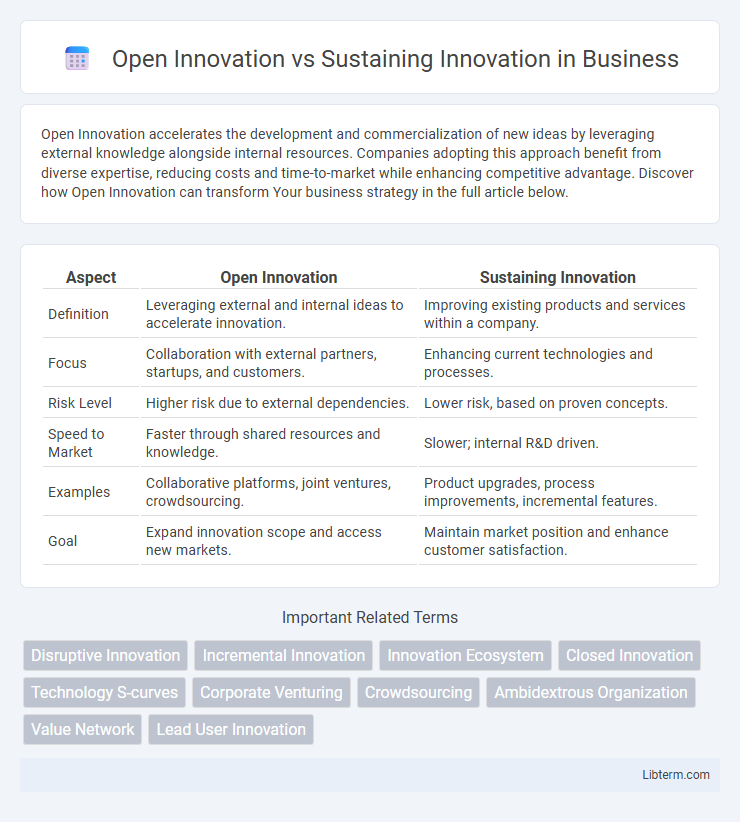Open Innovation accelerates the development and commercialization of new ideas by leveraging external knowledge alongside internal resources. Companies adopting this approach benefit from diverse expertise, reducing costs and time-to-market while enhancing competitive advantage. Discover how Open Innovation can transform Your business strategy in the full article below.
Table of Comparison
| Aspect | Open Innovation | Sustaining Innovation |
|---|---|---|
| Definition | Leveraging external and internal ideas to accelerate innovation. | Improving existing products and services within a company. |
| Focus | Collaboration with external partners, startups, and customers. | Enhancing current technologies and processes. |
| Risk Level | Higher risk due to external dependencies. | Lower risk, based on proven concepts. |
| Speed to Market | Faster through shared resources and knowledge. | Slower; internal R&D driven. |
| Examples | Collaborative platforms, joint ventures, crowdsourcing. | Product upgrades, process improvements, incremental features. |
| Goal | Expand innovation scope and access new markets. | Maintain market position and enhance customer satisfaction. |
Introduction to Open vs Sustaining Innovation
Open innovation accelerates product development by leveraging external ideas, technologies, and partnerships, expanding beyond internal R&D boundaries. Sustaining innovation, conversely, focuses on improving existing products or services within a company's current business model to meet evolving customer needs. These approaches contrast in scope and collaboration, with open innovation emphasizing external engagement and sustaining innovation targeting incremental internal enhancements.
Defining Open Innovation
Open Innovation refers to the practice where companies utilize external ideas, knowledge, and technologies alongside internal resources to accelerate innovation and bring new products or services to market. Unlike Sustaining Innovation, which focuses on incremental improvements within existing frameworks, Open Innovation leverages collaboration with external partners, startups, universities, and customers to drive breakthrough advancements. This approach enables organizations to expand their innovation ecosystem, reduce development costs, and access diverse expertise beyond traditional R&D boundaries.
Defining Sustaining Innovation
Sustaining innovation refers to incremental improvements made within existing markets and technologies to enhance product performance, quality, or features. It targets current customers by refining established solutions rather than creating entirely new value propositions. This type of innovation maintains competitive advantage by optimizing and evolving products without disrupting existing business models.
Key Differences Between Open and Sustaining Innovation
Open innovation emphasizes external collaboration by integrating ideas, technologies, and knowledge from outside the organization to accelerate development and market entry. Sustaining innovation focuses on enhancing existing products, services, or processes within the company, aiming to improve performance for current customers and maintain competitive advantage. Key differences include the source of innovation--external networks versus internal R&D--and the nature of impact, with open innovation driving disruptive breakthroughs and sustaining innovation refining incremental improvements.
Benefits of Open Innovation
Open Innovation accelerates problem-solving by leveraging external knowledge, resources, and technologies, increasing the pace of breakthrough product development beyond internal capabilities. It reduces R&D costs and risks through collaboration with startups, universities, and partners while expanding market reach via co-created solutions tailored to diverse customer needs. Enhanced adaptability and access to a broader innovation ecosystem position companies to respond swiftly to shifting market demands and technological disruptions.
Benefits of Sustaining Innovation
Sustaining innovation drives continuous improvement in existing products and services, enhancing quality and customer satisfaction in established markets. It strengthens competitive advantage by refining core technologies and processes, leading to increased efficiency and profitability. Organizations benefit from reduced risk and predictable returns by leveraging their current capabilities and market knowledge.
Challenges and Risks of Open Innovation
Open Innovation presents challenges such as intellectual property risks, loss of competitive advantages, and difficulties in managing external collaborations effectively. Companies often face issues with knowledge leakage, misaligned objectives between partners, and increased complexity in coordinating innovation efforts across organizational boundaries. These risks require robust governance structures, clear communication channels, and strategic alignment to maximize the benefits of Open Innovation while minimizing potential drawbacks.
Challenges and Risks of Sustaining Innovation
Sustaining innovation faces challenges such as market saturation, where incremental improvements fail to excite customers or differentiate products, leading to diminished competitive advantage. Risks include high R&D costs without proportional returns, as well as the potential of ignoring disruptive technologies that could render current innovations obsolete. Companies may also struggle with organizational inertia, limiting their ability to pivot and adapt quickly in dynamic markets.
When to Use Open Versus Sustaining Innovation
Open innovation is best utilized when organizations seek to leverage external ideas, technologies, or resources to accelerate breakthrough development and enter new markets quickly. Sustaining innovation is preferred for enhancing existing products or services to maintain competitive advantage within established markets. Companies should use open innovation during disruptive shifts or when internal capabilities are insufficient, while sustaining innovation suits incremental improvements and customer retention.
Future Trends in Innovation Strategies
Future trends in innovation strategies emphasize the integration of open innovation models, leveraging external knowledge networks and collaborative ecosystems to accelerate breakthrough developments. Sustaining innovation remains crucial for incremental improvements, enhancing existing products and processes through continuous refinement and customer feedback. Hybrid approaches combining open innovation's expansive idea sourcing with sustaining innovation's focus on market stability are driving companies toward more adaptive and resilient innovation portfolios.
Open Innovation Infographic

 libterm.com
libterm.com